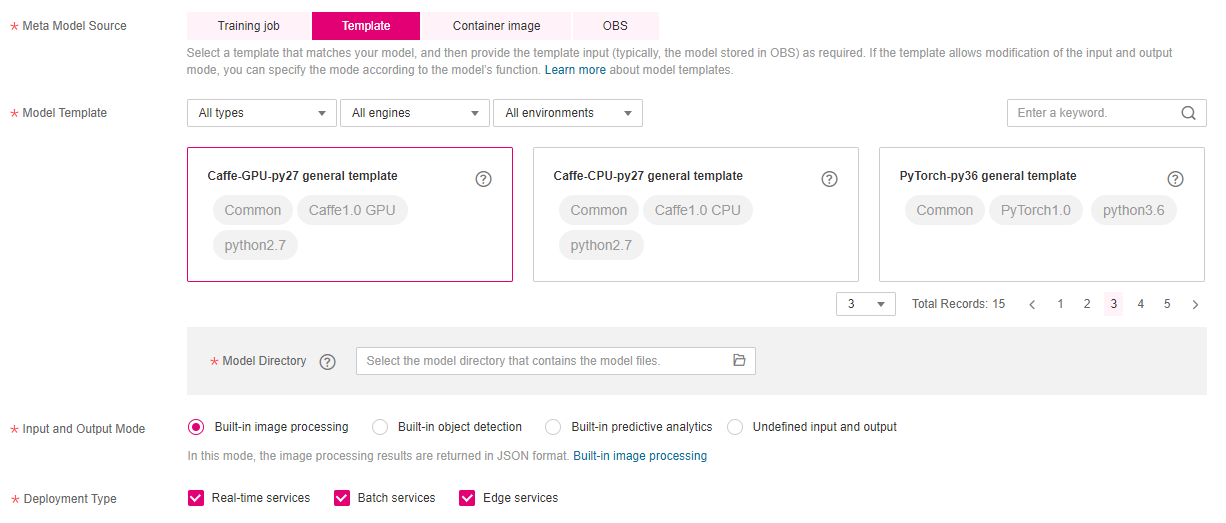Importing a Meta Model from a Template¶
Because the configurations of models with the same functions are similar, ModelArts integrates the configurations of such models into a common template. By using this template, you can easily and quickly import models without compiling the config.json configuration file.
Background¶
Because the configurations of models with the same functions are similar, ModelArts integrates the configurations of such models into a common template. By using this template, you can easily and quickly import the model. For details about the template, see Introduction to Model Templates.
For details about the supported templates, see Supported Templates. For details about the input and output modes of each template, see Supported Input and Output Modes.
Ensure that you have uploaded the model to OBS based on the model package specifications of the corresponding template.
The OBS directory you use and ModelArts are in the same region.
Procedure¶
Log in to the ModelArts management console, and choose Model Management > Models in the left navigation pane. The Models page is displayed.
Click Import in the upper left corner. The Import page is displayed.
On the Import page, set related parameters.
Set basic information about the model. For details about the parameters, see Table 1.
Table 1 Parameters of basic model information¶ Parameter
Description
Name
Model name. The value can contain 1 to 64 visible characters. Only letters, digits, hyphens (-), and underscores (_) are allowed.
Version
Version of the model to be created. For the first import, the default value is 0.0.1.
Label
Model label. A maximum of five model labels are supported.
Description
Brief description of the model
Select the meta model source and set related parameters. If Meta Model Source is set to Template, set other parameters by referring to Table 2.

Figure 1 Setting Meta Model Source to Template¶
Table 2 Parameters of the meta model source¶ Parameter
Description
Model Template
Select a template from the existing ModelArts template list , such as TensorFlow-based image classification template.
ModelArts also provides three filter criteria: Type, Engine, and Environment, helping you quickly find the desired template. If the three filter criteria cannot meet your requirements, you can enter keywords to search for the target template. For details about the supported templates, see Supported Templates.
Model Directory
OBS path where a model is saved. Select an OBS path for storing the model based on the input requirements of the selected model template.
Note
If a training job is executed for multiple times, different version directories are generated, such as V001 and V002, and the generated models are stored in the model folder in different version directories. When selecting model files, specify the model folder in the corresponding version directory.
Input and Output Mode
If the default input and output mode of the selected template can be overwritten, you can select an input and output mode based on the model function or application scenario. Input and Output Mode is an abstract of the API (apis) in config.json. It describes the interface provided by the model for external inference. An input and output mode describes one or more APIs, and corresponds to a template.
For details about the supported input and output modes, see Supported Input and Output Modes.
Deployment Type
After the model is imported, select the service type that the model is deployed. When deploying a service, you can only deploy the service type selected here. For example, if you only select Real-time services here, you can only deploy real-time services after importing the model.
Set the inference specifications and model description.
Min. Inference Specs: If your model requires certain resources to complete inference, you can configure this parameter to set the minimum specifications required for normal inference after the model is deployed as a service. In later versions, the system will allocate resources based on the inference specifications in service deployment. You can also modify the specifications as required during deployment. Note that the specifications configured here are valid only when real-time services are deployed and the dedicated resource pool is used.
Model Description: To help other model developers better understand and use your models, provide model descriptions. Click Add Model Description and then set the document name and URL. A maximum of three model descriptions are supported.

Figure 2 Setting the inference specifications and model description¶
Check the information and click Create Now. The model is imported.
In the model list, you can view the imported model and its version. When the model status changes to Normal, the model is successfully imported. On this page, you can create new versions, quickly deploy models, publish models to the market, and perform other operations.
Follow-Up Procedure¶
Model Deployment: On the Models page, click the triangle next to a model name to view all versions of the model. Locate the row that contains the target version, click Deploy in the Operation column, and select the deployment type configured when importing the model from the drop-down list. On the Deploy page, set parameters by referring to Introduction to Model Deployment.